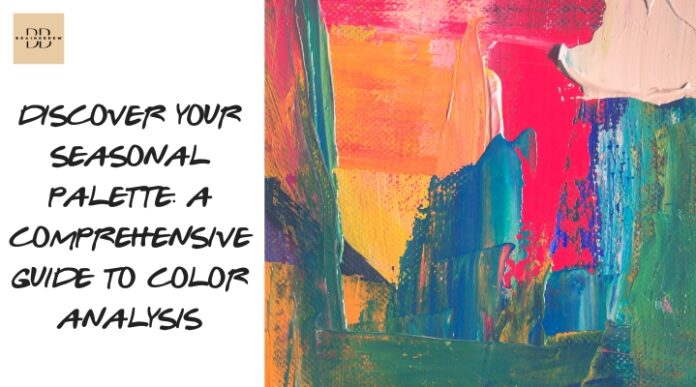Have you ever wondered which shades go with your coloring according to science? What colors suit you best based on your natural features like skin, eyes, and hair? If yes, then read the following to understand different seasonal colors, the benefits of using the particular color theory, and the ways you can find your color!
What is Color Analysis?
Color Analysis is determining which colors truly go with you from all the different ranges of colors. Every person has a specific palette that goes perfectly with their natural appearance. For example, Some people look flawless in pastels, while others rock black outfits. It happens when we come across our color theory answers and dress up in a way that brings our natural features fully to the surface!
What is a Seasonal Palette?
A seasonal palette is a range of colors divided into four seasons: summer, spring, autumn, and winter. There are 12 different colors inside these four palettes, from which the most identical ones are allotted to you according to your appearance. Through the color analysis test or a skin tone season quiz, we can determine what season color is ideal for you.
Advantages of understanding your Seasonal Palette:
1. Gives you your aesthetic
When you know your colors, you’ll get the clothing, makeup, and other overall personality products in those particular colors of the palette. This will help make your aesthetic so that everybody will get to know your style.
2. Saves cost for the long term
If you are aware of your seasonal colors, you’ll know which hues of the color palette suit you best and which don’t. It will help ban the products of the colors that don’t work in your favor.
3. Helps in making your look harmonious
The mix and match between a certain palette creates a perfect contrast and provides a significant, cohesive look.
The Four Main Steps In Color Theory:
As we know, four shades from the season’s color are mainly used to determine your color palette. Furthermore, these four seasons have twelve color concepts: Complementary, Warm, Neutral, Monochromatic, and more that are in range in the color theory. These four seasons have three main sub-points: Light, True, and Deep. Lastly, these three subpoints have additional points for the color season analysis: hue, value, and chroma.
How to find your Seasonal Palette?
Depending on your skin, eyes, or hair coloring, a particular season is assigned to you.
You should also get your colors done if you’d like to know your ideal shades. There are thousands of websites online where you can take the color season quiz or color swatches for color analysis. If you’d like a professional opinion, there’s always an option for a professional paid consultation.
Hare the four groups of the seasonal color palette analysis based on the seasons on earth:
Summer Color Palette
The summer season color analysis comes into three forms: light, actual/cool, and soft summer.
You can typically envision summer coloring skin tones as light to medium tones, typically golden or peachy skin. Summer season color analysis for eyes can combine brown, gray, or green. And the hair has cool undertones of ash.
Spring Color Palette
Spring embodies shine and bright shades. Like this season, which is about a joyful and cheerful nature, spring color analysis also comes off as a high-contrast palette. Spring seasonal color analysis offers a rich background, as they are a unique combination of temperature, light, and an evocative visual. Usually, we can see vibrant colors like red, turquoise, and yellows in the feature.
Autumn Color Palette
This warm and comforting palette has some super deep undertones. The earthy colors of cinnamon, sienne, browns, and rich reds are fairly common for this palette, with golden or auburn highlights in hair and brown, hazel, or green eyes. The skin tone seen is mostly golden and peachy. The autumn seasonal color analysis is filled with some lovely shades. They add a hint of mystical and mysterious tones to the overall vibe.
Winter Color Pallette
If you look at the winter color analysis, you’ll find icy and bright colors are quite common. The best colors for a winter skin tone include porcelain to olive complexion. The colors for winter eyes are deep, dark colors like brown and black. Colors for winter complexion include high usage of icy blues, metallics like grey and hold, and muted tones of lavender and red. The hair color has both dark and light tones. The colors that you should avoid for this palette are warm ones.
FAQS
How to do color analysis?
You can do the color analysis with the methods of color draping (where different colored fabrics will be draped around the face to see which suits the best), visual assessment either all by yourself or from a professional, or take quizzes online.
What is the difference between summer and winter color palettes?
Both the summer and winter color palettes are versatile. These palettes consist of very different colors. Summer has soft and muted shades, while winter is more dramatic and crisp. The primary colors you may find on these pallets are:
Summer: Blues, greens, purple, corals, and lavender.
Winter: Black, white, silver, and bright blues.
How to figure out what colors look good on you?
According to the color analysis test, everybody has a specific color season associated with them. Once you take your quiz or do color draping, then you’ll be able to find what color looks best on you.
Conclusion
Remember that the color season test doesn’t consider your body type or inner personality while finding your color season. Once you take the quiz, you’ll come to know the shades that suit you the best and make any styling yours! But you can always experiment with your choices even after the test for some new and interesting looks!

